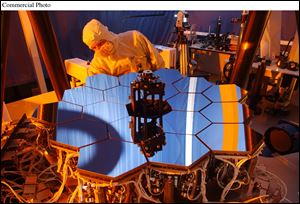
Ambitious project will send Hubble Space Telescope successor in search of Big Bang
1/12/2013
A Ball Aerospace engineer inspects the James Webb Space Telescope testbed telescope.
LOS ANGELES -- By the end of this decade, scientists may start rewriting textbooks on the earliest days of the universe thanks to an ambitious project based in Redondo Beach.
Engineers at Northrop Grumman Corp.'s Aerospace Systems sector are leading an industry team developing a telescope to look back in time to the period right after the Big Bang when stars and galaxies were starting to form.
Called the James Webb Space Telescope, the NASA-funded program is often described as the successor to the better known Hubble Space Telescope. Hubble was launched in 1990 and produced images of stars that existed more than 12 billion years ago.
However, the James Webb has a more ambitious mission, to peer into the heavens about 13.7 billion years in the past.
Northrop's progress, often described as a process of retiring risk, has been methodical and meticulous as groundbreaking technologies went from sketches on a computer screen to reality.
"You retire risk incrementally," said Scott Willoughby, Northrop's James Webb program manager. "You don't build the whole piece. You build a small piece and it works. Then you build another piece and it works."
About 500 people at Northrop's Space Park campus in Redondo Beach work on the project. Worldwide, about 1,200 skilled workers are involved in production and testing including at various industry partners.
The telescope has a five-year mission, although it is designed to last 10 years.
With NASA's guidance and funding, Northrop has made significant progress toward a scheduled 2018 launch that will send the space telescope into a spot 1 million miles from Earth.
In 2002, NASA named TRW Inc. as prime contractor for the James Webb. The following year, Northrop purchased TRW and took over the high-profile program.
A major element of the James Webb will be a giant mirror nearly 22 feet across to gather light that will be used to produce images of stars and galaxies. Because the mirror is so large, it will be composed of 18 hexagonal segments that will unfold after the telescope enters space.
The mirrors are coated with a thin layer of gold to enhance reflectiveness. Those mirrors have already been fabricated by subcontractor Ball Aerospace in Boulder, Colo., and underwent hours of polishing to achieve the ideal shape.
"We were literally stripping atoms in the final stage," Willoughby said of the polishing process.
Another major component of the space telescope is an aluminum-coated sun shield that will unfurl in space to stretch the length of a tennis court. The sun shield will protect the giant mirror and sensitive instruments from the sun's heat.
On the sun shield's "cold" side, the temperature will be a super-freezing minus-385 degrees Fahrenheit, which is close to absolute zero, theoretically the lowest possible temperature.
On the other side of the sun shield, the temperature will be a hot 185 degrees Fahrenheit.
The ability to separate such an extreme temperature range of nearly 600 degrees just a few feet apart adds to the technological challenge, Willoughby said.
"It's knocking it (temperature) down a little more and a little more and a little more," Willoughby said of the five-layer sun shield.
Three of the sun shield's five membrane layers have already been produced.
The mirrors and sun shield represented the biggest engineering challenges of the telescope. That is why their development schedule started earlier than other parts of the spacecraft, such as the telescope's bus.
The bus, the vehicle that will serve as the telescope's platform in space, recently entered the production phase using composite material made at Northrop's El Segundo facility that builds aircraft parts.
"Everything we're doing is a lot more tangible," Willoughby said. "We're really moving into production."
Despite the telescope's technical achievements and importance to the scientific community, the program has faced serious funding challenges.
In 2011, a House Appropriations Committee proposed in a spending bill to cancel the James Webb mission, which was behind schedule and over budget with an estimated cost of $8.7 billion.
However, lobbying by Northrop and prominent members of the science community helped restore funding for the mission, which is often referred to by its acronym JWST.
"Since the replan was put in place in 2011, we've been meeting our milestones," said Jeff Yoder, NASA's James Webb program director. "JWST is an agency priority. As such, the agency is doing everything it can to minimize any impacts of (budgetary challenges)."
While testing and production are being conducted in various locations, the telescope's final integration into a single spacecraft will occur in Redondo Beach.
Then the telescope will be packed up and shipped on a barge from the Port of Los Angeles through the Panama Canal to French Guiana in South America.
That is where James Webb will be launched into space and start its two-month trip to its final destination.
By that point, the sun shield and mirrors will have fully unfurled and deployed with an eye to the universe's past.
Northrop has a 100 percent success rate on its deployments. Yet Willoughby said that stage is what concerns him the most.
"When you have to do a large deployment on orbit, that's one of the riskiest things," he said. "You always worry about the stuff working."